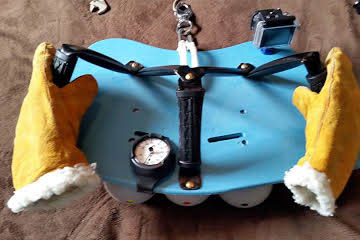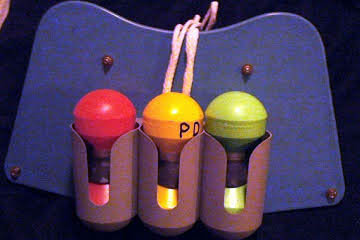An Underwater Diver Tow System developed by Paul Darnbrough is designed to help divers more efficiently explore debris fields from shipwrecks or submerged aircraft and anything else that may be of interest to them.
He developed three different modes of the system to accommodate the needs of divers. In each case his first concern is safety.
 Darnbrough likens his “single-diver” mode to towing a person on a tube behind a boat. It has a tube pulley attached to the boat’s transom, followed by a pair of 60-foot tow ropes, 120 feet in all. He says this allows a diver to be well away from the propellers as well as enabling him or her to reach maximum depths of 80 feet. A third rope can be added for more depth and distance off the boat if needed.
Darnbrough likens his “single-diver” mode to towing a person on a tube behind a boat. It has a tube pulley attached to the boat’s transom, followed by a pair of 60-foot tow ropes, 120 feet in all. He says this allows a diver to be well away from the propellers as well as enabling him or her to reach maximum depths of 80 feet. A third rope can be added for more depth and distance off the boat if needed.
The tow board, which is a platform with handles, is attached to the tow rope with a quick disconnect. The board has a mount for a Go Pro and a depth gauge, as well as a set of floating markers to allow divers to mark an interesting target that should be further investigated. The diver enters the water and a given time is allowed for the diver to hit a given depth. At that predetermined time the boat is put in drive and slowly starts to move. The diver is pulled through the water like being on a scooter. He steers by tilting the board up, down, left or right.
The second mode is the two-person system so two divers can be towed side by side. “This not only puts a second set of eyes on a larger search area . . . but it allows for two divers and the buddy system to be used by those not comfortable being underwater solo.”
 This system starts with a 10-foot length of composite 2×4, which does not rot and floats as well. “Two 20-foot tag lines keep the 2×4 plank well away from the motor (propeller). As well, the plank allows one to hook up two separate tow lines. The divers are about nine feet apart, which should allow each diver to maintain a visual with their tow buddy. It also allows them the space so as not to collide with each other while gliding through the water.”
This system starts with a 10-foot length of composite 2×4, which does not rot and floats as well. “Two 20-foot tag lines keep the 2×4 plank well away from the motor (propeller). As well, the plank allows one to hook up two separate tow lines. The divers are about nine feet apart, which should allow each diver to maintain a visual with their tow buddy. It also allows them the space so as not to collide with each other while gliding through the water.”
From the tow plank back it is the same as a single-diver set up with one small difference – the tow boards are set up as a left and right side. This way a pair of GoPros can be as far apart as possible. This allows for a greater field of viewing while recording for possible viewing later on a lap top.
Darnbrough said the third part of the system and the most important is safety. It must be discussed before the divers get in the boat. “As the leader of the group I take it upon myself to do an extensive safety briefing with all parties at the same time so as to make sure everyone is on the same page before we start out.”
There must be a minimum of two people in the boat while divers are being towed. A competent boat driver who knows marine rules and procedures and knows how to respond if things go wrong is required. Having a driver who is also a diver helps in maintaining a slow and safe speed while towing a fellow diver and the safety needed while having divers in the water around a running engine.
The second person in the boat is the spotter, whose job is to watch behind the boat as well as watching for other boaters running too close. The spotter should also watch for the tow boards surfacing when the towed diver lets go to signal the dive is over and then help collect lines and boards in the water. “The spotter also looks out for the surface marker telling the top side crew the diver is in safety stop mode and the location he will need to be picked up,” says Darnbrough.
He only uses “very experienced divers.” With each of them he makes sure they understand and follow the rules. Divers will need a couple of pieces they may not dive with normally. He insists on a good, real as well as a large surface marker and a redundant air source. “While diving a single tank or doubles, the diver must have a pony/stage bottle for safety. If diving side-mount it is up to the diver but I prefer a pony/stage bottle as well.”
The fourth and final part of his Underwater Diver Tow System involves putting it all together and explaining how it works.
“First off, all the computer investigations and mapping of the crash site area are done before the boat is even hooked to the truck to head out to the lake. All charts are marked and GPS numbers entered in to chart plotters. Gear is all packed in both the truck and boat.
“Out on the water we have arrived at the planned GPS spot and start to gear up. While the diver sets his gear up I would be hooking up the lines and adding the tow board allowing it all to float tangle free in the water. Before the diver gets in the water we would have a final pre-dive briefing on what we are about to do so as to have all parties on the same page.”
On entering the water, the diver swims the line back to straighten it out. When the diver is well away from the boat the driver will go forward to help stretch out the line. “Once the diver has the line straight with boat in neutral, he would signal the start of his descent for the given time discussed at the pre-dive briefing. Once the time is passed the captain puts the boat in drive and maintains a speed no more than three and a half to four kilometres an hour. This speed will allow the diver to breathe safely as well as maintain good visibility. At this point the captain starts with the aid of a chart plotter a predetermined search grid.
The diver is towed around and through a debris field of the aircraft you have been searching. If the diver spots anything that he feels is important for further exploring he would drop a float on the spot to be marked and dived at a later time.






